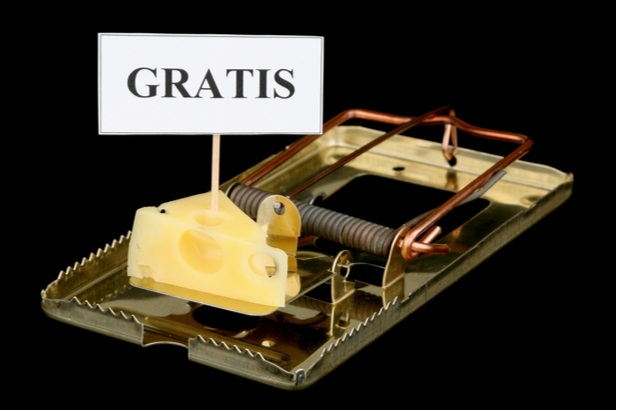 What's an investor to do? On the face of it, it looks like you're being offered something for nothing. Well, you might not see the strings attached, but there certainly are strings attached. (Photo: Shutterstock)
What's an investor to do? On the face of it, it looks like you're being offered something for nothing. Well, you might not see the strings attached, but there certainly are strings attached. (Photo: Shutterstock)
Remember that Twilight Zone episode where the aliens fed the humans? Based on the 1950 short story of the same name, “To Serve Man” first aired on March 2, 1962. At some point, the main character wonders, “Why do they keep feeding me? Are they genuinely interested in my well-being? Or are they just fattening me up?
There's never a free lunch. There's always a catch. There's always an ulterior motive.
We're seeing this concept play out live in that wonderful cauldron of marketing mischief known as the mutual fund industry (see “The Fiduciary Duty to Investigate Conflicts-of-Interests with 'Zero' and 'Negative' Fee Funds,” FiduciaryNews.com, June 4, 2019). If this doesn't raise your “free lunch” warning radar, nothing will.
It started almost as a lark last summer: Fidelity decided to offer “Zero” fee mutual funds. It wasn't as though they weren't going to earn money off these things. There was certainly the securities lending side of things. A way to make a quick buck off of other peoples' money. Then there was also the upselling strategy. That's the whole point of a “loss leader” product.
But then last month the race to the bottom entered a strange, new dimension. It didn't stop at the bottom. It crashed right through the floor.
Now we have a mutual fund that, in essence, pays investors to become shareholders. By reimbursing the fund an amount greater than the expense ratio, the Salt Low truBeta US Market ETF actually has a “negative” fee. (At least until April 30, 2020, when the prospectus indicates this oversized reimbursement may end.)
What's an investor to do? On the face of it, it looks like you're being offered something for nothing.
Well, you might not see the strings attached, but there certainly are strings attached.
To understand those strings, you must first understand the purpose of “Zero” fee or “Negative” fee funds. There simply is only one purpose: build market share.
These savvy marketers know full well incessant media reports have vilified fees, even legitimate ones. This has created a “low fee” bandwagon, drawing investors from other, perhaps more critical, factors when making investment decisions. (Incidentally, the same thing is happening with “ESG”-centric investment products. In fact, I'd be willing to wager you can get away with purposely charging a premium fee as long as the product has the ESG seal of approval.)
The cattle prod of “low” fee begets a stampede when you change “low” to “Zero” or “Negative.” Smart marketers realize such a change is enough to overcome the natural inertia of staying put. The horde comes in looking for its pound of something-for-nothing opportunity. And, much to their delight, they find their thirst immediately quenched.
Eventually, however, all good things must come to an end. The free lunch can't go on forever. Once it's milked the market of the most naïve, its fees will regress to the mean.
Except people won't leave. There's a new inertia now and they've settled in for the long term.
Or at least until the next “Negative” fee fund comes along.
Maybe that one will be called “It's a Cookbook!”
READ MORE:
A 3-word fiduciary rule — Carosa
The 'Fiduciary Rule' versus the 'Rule of Fiduciary' — Carosa
© 2025 ALM Global, LLC, All Rights Reserved. Request academic re-use from www.copyright.com. All other uses, submit a request to [email protected]. For more information visit Asset & Logo Licensing.







